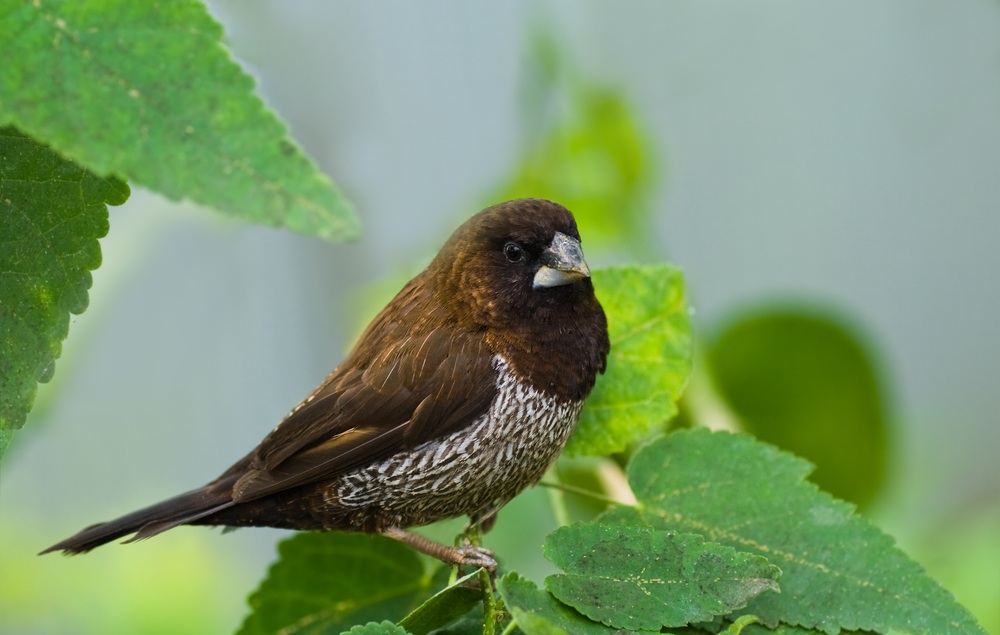Canaries/Finches
Bengalese Finch (Society Finch)

Origins
Unknown. Believed to have been developed in Japan from birds originally bred in China. Bengalese (Lonchura striata domestica) are unusual, because they are fertile domesticated hybrids. They are thought to have been created by crosses involving the white-backed munia (L. striata).
Length
13cm (5in)
Appearance
Typical finch shape, with stocky bill. Coloration variable, thanks to the creation of a number of colour forms. The chocolate self may be considered the original form.
Variants
There are a number of feather variants established, although most are not well-known outside Japan. The crested form is widely-kept though - this takes the form of a full circular crest. There is no lethal factor associate with this mutation, so crested to crested pairings can be carried out, although it is dominant so that a percentage of chicks bred from crested x non-crested pairings will still be crested in appearance. There is a much rarer frilled form, called the chiyoda, which can be combined with the crested mutation to create the chiyoda bonton. Other mutations, with a frill behind the neck rather than on the chest for example, and sometimes with a crested appearance have also been created in Japan.
Colour forms
Alongside the chocolate, a fawn variant has been well-known in the West for many years. An albino version was the first example of the Bengalese to be seen in Europe, being exhibited at London Zoo in 1860. Such birds can be distinguished from dark-eyed whites by virtue of their red eyes. Another pale colour is the creamino, which varies from a creamy shade to white.
Chestnut Bengalese have become more common over recent years, again showing some variability in depth of colour, which can range from a pale milk coffee shade to a true chestnut. Fawns and greys are also now being bred. Grey, as with pied can be introduced to all the colours other than pure white.
One of the newer colours which originated during the 1980s in Japan is the so-called pearl, which has a slightly silvery appearance just like a pearl. Dilute forms of Bengalese are widely-kept, with their coloration being less intense than in the equivalent normal form. In the case of the clearwing, so the wings themselves are paler in colour than the head. There is also growing interest in creating composite variants, such as clearwing grey fawns.
Purchasing
It is better to acquire a small group of four or more at the outset, to be sure of having a breeding pair. Young birds will be mature within a year.
Sociability rating
Highly social by nature, and will thrive in colonies, which is why in the US especially, these birds are better-known as society finches. Can also be housed with other small finches and softbills, even diamond doves (Geopelia cuneata), but avoid larger species such as Java sparrows (Padda oryzivora) which may bully them.
Suitability
Ideal choice for newcomer to the hobby, the intending exhibitor, or, increasingly, those interested in genetics and establishing new varieties. Can be housed and bred either indoors in spacious flight cages, in birdrooms or outdoor aviaries. Also used as foster parents to hatch and rear the chicks of Australian finches such as Gouldians (Chloebia gouldiae).
Care
If kept indoors on a permanent basis, then bathing facilities must be offered. An aviary for these finches should be sheltered, and may need to be provided certainly with artificial lighting, to increase the opportunity for feeding during the dark days of winter, while heating too may be beneficial. Not destructive or noisy.
Feeding
A typical foreign finch seed mix with suit Bengalese well, augmented with a vitamin and mineral supplement. Greenfood such as chickweed should be supplied regularly, along with a soft food which is likely to be eaten in increasing quantities when chicks are being reared.
Breeding
A small finch nest box or nesting basket will be used for this purpose, with the cock revealing his identity at this stage by singing and displaying in front of an intended mate. It can be worthwhile ringing cock birds at this stage using split celluloid rings, which simply clip over the leg, so they can be recognised throughout the year.
Breeding data
A typical clutch is likely to be comprised of five or six eggs, with incubation taking approximately two weeks. Fledging usually occurs when the chicks are just over three weeks old. They can then be transferred elsewhere once they are feeding on their own, about two weeks later, by which stage the adult birds may be nesting again. They can rear two or three clutches in a season.
Caution
Be sure to provide a good choice of nesting sites, preferably at the same height in a communal aviary, to reduce the risk of any squabbling during this period.
Potential lifespan
Can be seven or eight years.